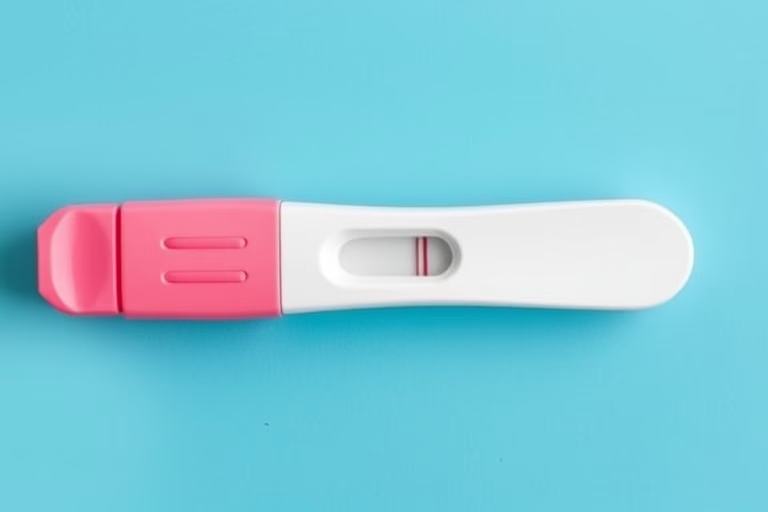Understanding Implantation Bleeding
We will be talking about when to take a pregnancy test after experiencing implantation bleeding. Implantation bleeding refers to light spotting that occurs when a fertilized egg attaches itself to the lining of the uterus. This usually happens around 6 to 12 days after conception, and it can be a sign of early pregnancy for many women. Unlike a typical menstrual period, implantation bleeding is often lighter in color, ranging from pink to brown, and usually lasts for a few hours up to a couple of days.
The timing of implantation bleeding varies from woman to woman, but it is generally an early indicator of pregnancy. Many women may confuse it with their period, leading to questions about when to take a pregnancy test. Understanding when to conduct a home pregnancy test after experiencing this kind of bleeding can provide significant clarity for those trying to conceive. Taking the test too early may result in a false negative, as the body may not have produced enough human chorionic gonadotropin (hCG)—the hormone detected in pregnancy tests—for the test to register a positive result.
When Does Implantation Bleeding Occur?
Implantation bleeding occurs typically between 6 to 12 days post-ovulation and fertilization. It is critical to understand this timeframe so that individuals can identify their fertility cycle accurately and recognize signs of pregnancy early. The timing of this bleeding is often around the time when a woman is expecting her menstrual cycle, which adds to the confusion in distinguishing between the two.
This bleeding may last anywhere from a few hours to a couple of days and varies in color from light pink to brown. Most importantly, the flow is lighter than that of a typical menstrual period, and it does not come with the usual cramping or discomfort associated with menstruation. Knowing this timeline helps in understanding when to take a pregnancy test effectively.
For best results when taking a pregnancy test, it’s advisable to wait until at least one week after the implantation bleeding. Waiting allows your body time to build enough hCG in the bloodstream or urine, ensuring the accuracy of the test.
How to Recognize Implantation Bleeding
Recognizing the signs of implantation bleeding is essential for those trying to conceive. The distinguishing characteristics of implantation bleeding include:
- Color: It is typically pinkish or brownish, as opposed to the bright red usually associated with menstruation.
- Volume: The blood volume is lighter, often just a few drops.
- Duration: Implantation bleeding can last from a few hours to two days, contrasting with a period that lasts several days.
- Cramps: Light cramping may accompany the bleeding, but it is usually much milder than menstrual cramps.
By being aware of these specific details, individuals can better understand their bodies and determine the right time to take a pregnancy test to avoid unnecessary confusion.
When Is the Best Time to Take a Pregnancy Test?
The ideal timing to take a pregnancy test after experiencing implantation bleeding is crucial for accurate results. You should wait until the first day of your missed period. By this time, your hCG levels should be sufficiently high to register on most home pregnancy tests.
If your cycle is irregular or you’re unsure of when your next period is due, wait at least one week after the bleeding stops before taking a test. It is generally recommended to follow these steps:
- Track your ovulation date to determine when you may have conceived.
- Monitor the timing of your implantation bleeding.
- Wait at least one week after the bleeding stops to take the test.
- Use the first urine of the morning for the most concentrated hCG levels.
Taking these steps helps ensure the best chance of obtaining an accurate pregnancy test result.
Tips for Maximizing Pregnancy Test Accuracy
To achieve the highest accuracy on a pregnancy test, consider these guidelines:
- Read the test instructions carefully before use.
- Use a test that is known for high sensitivity, preferably one that can detect low levels of hCG.
- Conduct the test in the morning, as urine is most concentrated.
- Ensure the test is within its expiration date.
- Consider retaking the test a few days later in case of doubt.
Following these tips minimizes the risk of false negatives and provides peace of mind during the anxious waiting period.
Understanding False Negatives
False negatives can occur when a pregnancy test fails to detect the presence of hCG in the urine, leading to a negative result despite being pregnant. Several factors contribute to false negatives, including:
- Testing too early: If the test is taken before the hCG level has increased sufficiently, it may yield a negative result.
- Low sensitivity of the test: Not all tests are created equal. Some are designed to detect lower levels of hCG than others.
- Diluted urine: If you drink a lot of fluids before testing, it may dilute the urine and affect the results.
To combat the risk of false negatives, consider taking the test after a missed period and opt for tests known for high sensitivity. Understanding these factors can reduce anxiety and uncertainty in this critical period.
What to Do After Testing Positive
If the pregnancy test turns positive, congratulations! The next step is to schedule an appointment with a healthcare provider. Early prenatal care is essential for a healthy pregnancy. At your appointment, healthcare providers will typically confirm the pregnancy through a blood test and discuss the next steps in terms of care and monitoring throughout your pregnancy journey.
Additionally, it’s important to start prenatal vitamins and evaluate your lifestyle choices, such as diet and exercise, which will now reflect your pregnancy status. Making healthy choices can significantly impact both your pregnancy and your baby’s health.
Final Thoughts
Implantation bleeding and the timing of pregnancy tests can create a sense of uncertainty for many women. Understanding when implantation bleeding occurs, how to distinguish it from a menstrual period, and knowing the correct timing to take a pregnancy test is vital for those actively trying to conceive. It is generally advised to wait until the day after a missed period to ensure the most accurate test result. Monitoring hCG levels and following specific testing tips helps maximize accuracy.
Additionally, recognizing factors that can lead to false negatives prepares women for the possibility of needing follow-up tests. Consulting a healthcare provider upon receiving a positive pregnancy test opens the door to receiving vital care during a crucial period in life. Preparing for pregnancy requires careful consideration of your health and wellbeing.
To summarize:
- Understand what implantation bleeding is and its timing in relation to conception.
- Recognize the signs of implantation bleeding to distinguish it from menstruation.
- Know when to take a pregnancy test for accurate results.
- Follow tips for maximizing test accuracy and understanding potential false negatives.
- Take proactive steps after testing positive for a healthy pregnancy.
With this knowledge, individuals can navigate their pregnancy journey more confidently and mindfully.
Frequently Asked Questions
1. What is the difference between implantation bleeding and a menstrual period?
Implantation bleeding is lighter in flow, often pink or brown in color, and typically lasts only a few hours to a couple of days, while a menstrual period generally has a heavier flow and lasts several days.
2. Can I take a pregnancy test during implantation bleeding?
It’s better to wait at least one week after implantation bleeding ends to take a pregnancy test to obtain an accurate result.
3. How long after implantation bleeding can I get a positive pregnancy test result?
You can often receive a positive result one week after the implantation bleeding occurs, especially if it coincides with your missed period.
4. Are there any symptoms that accompany implantation bleeding?
Some women may experience mild cramping along with implantation bleeding, but it usually does not cause much discomfort or significant symptoms.
5. What should I do if my pregnancy test is negative but I suspect I am pregnant?
If you receive a negative test result but suspect pregnancy, wait a few days and take another test or consult a healthcare provider for further evaluation.
Further Reading
What Type of Psychotherapy Is Best for Anxiety?







